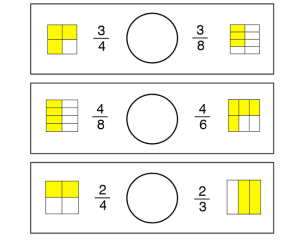From our experience in schools and recent reports from edreports.org, it is clear that textbook companies are still in the process of creating versions of their curriculum aligned to the Common Core State Standards for Mathematics, and many districts and schools are waiting until this fully aligned curriculum comes to the market before buying new materials. This means teachers are left to find ways to adapt their current curriculum to meet the new Standards, an incredibly daunting task. Our Adapting Instructional Materials Project evolved to fill this very need. We created a structure by which teachers could adapt their curriculum to follow the Standards’ trajectory and improve the teaching and learning in their classrooms. The project worked with two small New York districts to adapt their fractions teaching materials in grades 3-5. To do this, we created a three-step process:
- Understanding the Standards
- Investigating the existing instructional materials
- Finding and creating improvements in the materials using our modification template
Adapting every lesson to meet every standard was neither realistic nor our main goal, which was to create a replicable process for teachers intending to adapt their materials. Most importantly, we wanted to create an environment of trust, where teachers felt empowered with the knowledge, confidence, and authority to change their own instructional materials in a way that better reflected the Standards.
Understanding the Standards
To make instructional materials adaptations match the Common Core State Standards, it is first important for teachers to understand the standards they teach. We started by exploring the meaning of each of the standards within the fraction progression. We looked at the specific text in the Standards document, and rewrote that text in parent-friendly language to be more accessible for others.
We then extended our understanding by looking at student work and watching videos of students thinking about examples of difficult fractional concepts. We read the progressions document for fractions to think about the trajectory of the topic across grade levels and the elaborations of the Standards for Mathematical Practice to bring out the applicability of these practices in an elementary context. The Illustrative Mathematics’ fractions progression course videos, and main ideas of the fractions units in the Illustrative Mathematics course blueprints were helpful visuals for teachers to see the coherence of ideas across grade levels. We then looked at the progression of the fractions standards across grades through example tasks to better connect with the work students do in the classroom. By keeping our materials relevant to the classroom, and referencing as much student work as possible, we strove to keep the level of the discussion focused on classroom interactions and student understanding.
Investigating the existing instructional materials
After building a foundational understanding of the standards, we looked at connections between the standards and the school districts’ student textbooks, teacher manuals, and scope and sequence documents. At first we tried to identify parts of the textbook or lessons that could be eliminated because they did not cover grade-level standards. This method was not successful. While we all agreed that the Common Core Standards were more focused and deeper than past fractions work, it was too difficult to eliminate a lesson that a teacher remembered as producing great discussions and interactions in the classroom. Instead, we changed our tactic to thinking about what parts of the book and sequencing documents were most aligned to the big ideas of the Standards. This technique of choosing what to leave in, rather than what to take out, allowed us to trim down textbooks and sequences, focusing just on the big ideas of the Standards within fractions.
Finding and creating improvements
Finally, teachers either chose a part of their current textbook to adapt, or looked for other materials to supplement for a particular concept they felt was not covered completely in their existing materials. Teachers developed modifications guided by our modifications tool. They collected student work for these modifications, spent time learning about the EQuIP Student Work Protocol and applied it to the modifications they tried in their classrooms. Some modifications worked well with students but other modifications were less aligned to the Standards. Through collaboration, however, new tasks and games were developed and incorporated into scope and sequence documents in both of the districts. These newly developed tasks include Comparing fractions game, Comparing fractions using benchmarks game, and newly incorporated tasks include Snow day, and Folding strips of paper, among others.
 Classroom material from the newly developed Comparing Fractions game
Classroom material from the newly developed Comparing Fractions game
Overall, while adapting these materials, we tried to inspire a spirit of continual learning. From the facilitators, to the math specialists and coaches, to the teachers and their colleagues at different grade levels, everyone in the group was learning together and improving their understanding of the Standards and the mathematics. On a survey given at the beginning and end of the project, with questions asking about the fractions trajectory (what students learn in each grade) and Mathematical Knowledge for Teaching, teachers on average improved their scores by 13.6 percentage points in one district and 12 percentage points in the other. Our facilitation team’s biggest takeaway was that, while the modifications created were specific to the context of the teachers and school in which they worked, this process we developed could be used by many different teachers and schools to examine and adapt their instructional materials for mathematics.


















